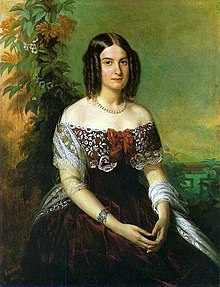Loading AI tools
From Wikipedia, the free encyclopedia
Maria Isabel de Alcântara Bourbon[1] (28 February 1830 – 5 September 1896)[1] was the third daughter (fifth child) of emperor Pedro I of Brazil and his mistress, Domitila de Castro, Marchioness of Santos.
Maria Isabel de Alcântara | |
|---|---|
| Countess of Iguaçu | |
 The Countess of Iguaçu, by Ferdiand Krumholz, c. 1852. | |
| Full name | Maria Isabel de Alcântara Bourbon |
| Born | 28 February 1830 São Paulo, Empire of Brazil |
| Died | 6 September 1896 (aged 66) São Paulo, São Paulo, Brazil |
| Buried | Consolação Cemetery |
| Spouse(s) |
Pedro Caldeira Brant, Count of Iguaçu
(m. 1848; died 1881) |
| Issue | 7 |
| Father | Pedro I of Brazil |
| Mother | Domitila de Castro |
Maria Isabel received the same name as her second sister, the Duchess of Ceará, who died in 1828 at only two months old.[2] Her father never gave her any titles due to his marriage to Amélie of Leuchtenberg. Still, Pedro I acknowledged her as his daughter in his will but gave her no share of his state, except asking for his widow to aid in her education and upbringing.[3] He wished she was given a good European education like her oldest sister, the Duchess of Goiás. However, the Marchioness declined to send the girl to Europe.
Maria Isabel was born on February 28, 1830, and inherited the same illness as her father, epilepsy. Maria Isabel's childhood was almost always in the shadow of an imperial family.
Even though she was the result of the extramarital affair between her father, D. Pedro I, and her mother, the Marquesa dos Santos, she grew up in the same way as her brothers. The consequences of this relationship only appeared later.
Her training follows the most perfect European model, she was instructed to learn the traditional rules of etiquette, just like her sisters. Her life was surrounded by dresses and porcelain, and it was a simple and common childhood for members of the Brazilian nobility.[4]
Everyone knew that Maria Isabel was the result of the relationship outside of marriage between Dom Pedro and the Marquesa dos Santos . Even so, she was raised to become the Countess of Iguaçu, a title she never received. With her emperor father, marquise mother and several heir brothers and half-siblings, she grew up to be part of the nobility. However, due to the adultery of which she was the result, she never received anything from her father, be it title or land.
She received vast lands from her half-brother Dom Pedro II of Brazil, among them several pastures and cattle in Juiz de Fora, Ouro Preto, in her districts of Antônio Pereira, Cachoeira do Campo, Lavras Novas and Amaranthine.
In addition to lands in Congonhas, Moeda and Mariana. She lived with her husband Pedro Caldeira Brant, Count of Iguaçu, they lived in the parish, town and city of Nossa Senhora da Piedade do Iguaçu, currently Nova Iguaçu in Engenho de Santo Antônio de Jacutinga, The property (now in ruins), is located at the top of a hill behind Uniabeu, what is today the municipality of Belford Roxo, in Baixada Fluminense.
On 2 September 1848, at the age of eighteen, Maria Isabel married Pedro Caldeira Brant, the Count of Iguaçu, son of Felisberto Caldeira Brant, Marquis of Barbacena.[5] At their wedding, Maria Isabel became the second Countess of Iguaçu.
The couple had seven children:
The death of Maria Isabel happened on September 6, 1896, the Countess of Iguaçu died at the age of 66. From that day on, even though Maria Isabel's life was over, a new mystery began.
Until around 2015, the whereabouts of his body remained a mystery. For up to approximately 120 years, no one was able to locate the place where she was buried. Unlike most of the imperial family, they are easily found in cemeteries.
The Countess used to travel between São Paulo and Rio de Janeiro for much of her life, which raises the question of what state she should be in. Furthermore, many Brazilian nobles were often buried in Europe, such as Germany and Portugal. But historians could not conclude where she was.
Recently, architect and historian Paulo Rezzutti decided to dedicate himself to finding the cemetery where Maria Isabel was buried. He analyzed various obituaries and newspaper stories and recounted the deaths of important people. That's how he discovered "As Raízes da Condessa de Iguaçu" published by O Estado de S. Paulo on September 6, 1896.
From this clue, he found the Civil Registry record of Santa Ifigênia, which said: “She was buried in the Municipal Cemetery”. She was buried in the Consolação Cemetery, the countess's coffin was next to that of her mother, the Marquesa de Santos. Rezzutti checked the municipal historical archive and found the tombstone. There was no adornment on the tombstone nor his name carved into the stone

Seamless Wikipedia browsing. On steroids.
Every time you click a link to Wikipedia, Wiktionary or Wikiquote in your browser's search results, it will show the modern Wikiwand interface.
Wikiwand extension is a five stars, simple, with minimum permission required to keep your browsing private, safe and transparent.